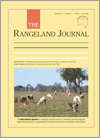The Rangeland Journal
Volume 41
Number 6 2019
Managing Total Grazing Pressure in Australia’s Southern Rangelands
The term ‘total grazing pressure’ has been developed in recent decades to denote the total forage demand of all vertebrate herbivores relative to the forage supply. Use of the term is currently almost exclusive to Australia, and particularly to the southern rangelands. However, the concept has wider relevance wherever pest animal control programs, biodiversity conservation, or commercialisation of wildlife are conducted in parallel with extensive livestock production. The rationale for the compilation of the Special Issue is outlined.
Land managers in the southern rangelands of Australia face the challenge of adjusting grazing pressure from both livestock and non-domestic herbivores relative to fluctuations in forage availability. Surveyed land managers and their service providers believe the grazing pressure from non-domestic animals should be reduced by about half to overcome negative impacts on soils, pastures, livestock production and business profitability. This paper contributes to a growing body of evidence that the unmanaged grazing pressure from non-domestic animals needs to be addressed to support improvements in resource condition and pastoral business profitability.
Landholders have primary responsibility for managing the grazing pressure from non-domestic herbivores in the nationally iconic southern rangelands of Australia. Governments are also involved in the management of native and feral animals via legislation and control programs. This paper explores the challenges faced by landholders to control grazing pressure by non-domestic animals, in particular, from kangaroos, feral goats and feral pigs while meeting the Australian public’s expectations for animal welfare. Landholders’ have limited capacity to control these species using socially acceptable practices. We argue that governments must accept more responsibility for managing this iconic Australian landscape.
Sustainable grazing management in the south-eastern rangelands of Australia needs to consider the impact of kangaroos, unmanaged goats and feral pigs as well as domestic livestock. Control practices to manage these species were assessed by individuals drawn from key stakeholder groups for acceptability. Most preferred were commercial shooting for kangaroos, a trap yard set at a water point for unmanaged goats, and ground shooting, trapping and 1080 baiting for feral pigs. The two key criteria for the social acceptance of a control practice were humaneness and effectiveness. Support for control programs to manage TGP must be justifiable and employ practices that are socially acceptable.
Kangaroos are thought to have much lower energy requirements than similar-sized sheep, but this review found they ate similar amounts of forage daily. With a DSE rating of 1, a 50 kg kangaroo contributes twice as much to total grazing pressure than previously reported. Based on dry matter intakes, a 50 kg goat is 1 DSE and a 450 kg steer is 8 DSE.
Equivalency of sheep, cattle, feral goats and the large macropods in the southern rangelands with regard to what and where they eat over their lifespans is high. Although diet composition and foraging distributions are often different at specific times, these tend to converge over the course of climatically different seasons and years.
Demonstrating sustainable land management (SLM) requires an understanding of the linkages between grazing management and environmental stewardship. Sometimes, rangeland pastoralists only have control over less than half the grazing pressure. When combined with livestock, unmanaged native kangaroo and goat populations contribute to total grazing pressure (TGP), which, when intense and persistent, may result in negative impacts on the environment and rangeland enterprises. Developing environmental indicators which reflect TGP management practices will support SLM and more profitable rangeland enterprises.
Concerns raised, including those voiced by animal rights and vegan activists, have limited the available practices by landholders in the southern rangelands to effectively control kangaroos and, over time, the actions of these groups may threaten the existence of the livestock industry. This paper draws on interviews with key stakeholders and workshops with technical experts and red meat industry participants to identify strategies to respond to this potentially existential threat.
The management of kangaroos in the rangelands of southern Australia is a contentious issue, and some stakeholders are dissatisfied with current management. Active adaptive management is an alternative approach to current management arrangements that has been successful at improving the management of natural resources elsewhere and provides a structured, adaptive approach to decision making. We recommend that kangaroo management in Australian rangelands be modified to follow an active adaptive management approach.
In the southern rangelands of Australia, domestic livestock often account for only about half of the total forage demand from herbivores, and hence management of total grazing pressure currently represents a case of market failure. Pastoral landholders are often unable to provide the level of kangaroo management, in particular, that is consistent with their private economic interests and the public expectations for resource conservation and animal welfare. The nature of this situation is outlined, along with several opportunities by which kangaroo management could be advanced and the pastoral industry’s social licence maintained.




